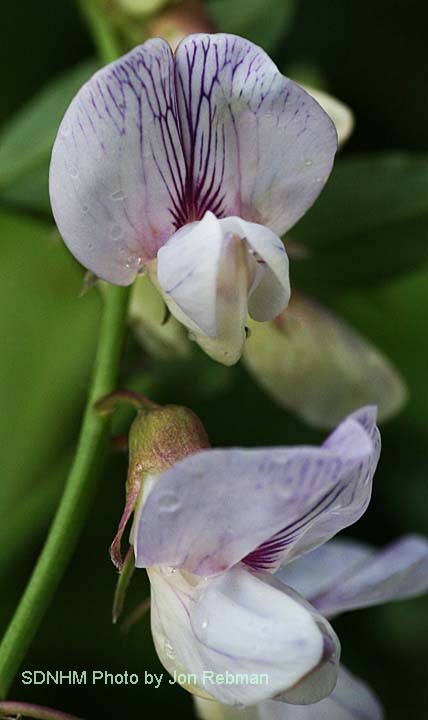Palmer’s Sagewort (Artemisia palmeri) https://www.inaturalist.org/observations/124162571 by @toyonbro
Palmer’s Grappling-Hook (Harpagonella palmeri) https://www.inaturalist.org/observations/117674798 by @spifferella

Palmer's Sagewort © James Connolly Davis

Palmer's Grappling-Hook © Becky Escalante
Other than their eponyms, Palmer’s Sagewort and Palmer’s Grappling-Hook have very little in common. They are in different families: Asteraceae for Palmer’s Sagewort and Boraginaceae for Palmer’s Grappling-Hook. Palmer’s Sagewort (Artemisia palmeri) is found in San Diego’s coastal lowlands and in Baja California. Palmer’s Sagewort looks a little like California Sagebrush (Artemisia californica) except the leaves are larger with broader lobes. The Royal Botanic Gardens, Kew, holds an herbarium sheet of a dried and pressed specimen of Palmer’s Sagewort which bears the collector’s personalized label annotated by Asa Gray. This was only 1 out of over 100,000 botanical specimens collected by Col. Edward Palmer, M.D. over his lifetime, but it was the “type” specimen used by Gray to describe the species for science. And it was collected by Palmer right here in San Diego County in 1875. Some sources describe the exact location within San Diego County as “Samuel Valley” based on a difficult-to-decipher handwritten legend on the label. Gray interpreted the writing to be “Jamuel” Valley suggesting the collection location was in Jamul Valley.
Palmer’s Grappling-Hook (Harpagonella palmeri) was collected by Palmer on Guadalupe Island, also on his 1875 trip, and later described by Asa Gray. It falls into the category of “little white popcorn flowers” and is harder to spot than Palmer’s other namesake plant! You can find it from the coast to the inland valleys in San Diego County and in other parts of Southern California and Baja California. On close inspection of Palmer’s Grappling-Hook you can see how the plant got its name. The fruits have prickly lobes that form what looks like a tiny grappling hook, earning the plant both its common name and the genus name which is a diminutive form of “harpago” from the Greek for a hook.
Both Palmer’s Sagewort and Palmer’s Grappling-Hook have a rank of 4.2 on the California Native Plant Society’s Inventory of Rare Plants indicating that they have limited distributions and are fairly threatened in California.
Palmer had many other plants named in his honor—over 200 species and several genera. Thirteen taxa named after Palmer are found in San Diego County. When describing the new genus Palmerella in 1876, Asa Gray wrote that he was dedicating the genus to Palmer “in acknowledgment of his indefatigable and fruitful explorations of the botany of the south-western frontiers of the United States, from Arizona to the islands off Lower California, in which region he has accomplished more than all his predecessors.”
Palmer was a transplanted Englishman who trained as a physician and served in the U.S. Army. He not only made prodigious collections of plants from across the Southwestern United States and Mexico, but also collections of anthropological objects, many of which are held at the National Museum of Natural History (Smithsonian Institution), and some of which are featured on their website. Of note is a collection of fiber prepared from Chaparral Candle (Hesperoyucca whipplei) for a horse blanket by Kumeyaay near Agua Caliente which Palmer acquired on his 1875 trip. Palmer has been called the father of ethnobotany due to his contributions to knowledge of plants and their uses by indigenous people.
During his 1875 expedition, Palmer remained in the San Diego area for about three months and in that time collected several thousand plant specimens, 24 of which are in the herbarium at the San Diego Natural History Museum. Palmer’s collecting expeditions spanned many decades and continued until a few years before his death in 1911 in Washington, D.C.










































